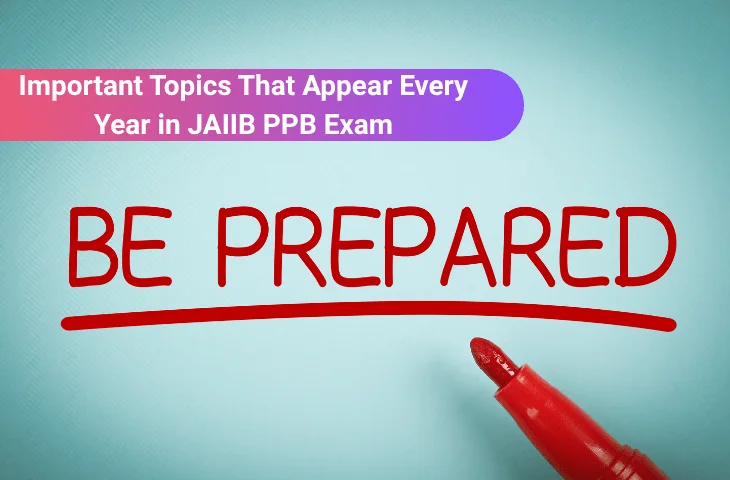The PPB (Principles & Practices of Banking) exam is a crucial assessment for banking professionals looking to strengthen their knowledge in banking operations, lending, digital banking, and regulatory compliance. For aspirants preparing for the upcoming JAIIB exam, which is scheduled to start on 2nd November with the PPB exam on 8th November 2025, focusing on repetitive topics that have mostly appeared in past exams can greatly improve your chances of scoring well.
Based on previous cycles and expert insights, certain topics in PPB have consistently contributed significant marks in each attempt. In this guide, we provide a detailed module-wise breakdown of must-know PPB topics so that you can focus your preparation strategically.
8 Essential Topics of JAIIB PPB
The 8 important JAIIB PPB topics are as follows:
- KYC and AML Norms
- Priority Sector Lending
- Lending Principles and Loan Products
- Digital Banking and Payment Systems
- Banker-Customer Relationship
- Ethics in Banking
- Negotiable Instruments Act
- Non-Performing Assets
JAIIB PPB Exam Pattern
The JAIIB PPB Exam 2025 is conducted in an online mode with no negative marking. The paper consists of 100 questions for 100 marks, and candidates are given 2 hours to complete the paper. After final submission candidates will get to know the total correct answers, they have marked in the paper. The details of the JAIIB exam pattern are as follows:
| Feature | Details |
| Total Questions | 100 objective-type MCQs per paper |
| Total Marks | 100 marks per paper |
| Case-Based Questions | Yes, included |
| Exam Mode | Online (CBT) |
| Negative Marking | No negative marking |
| Assessment Areas | Basic knowledge, application skills, case handling, and numerical aptitude |
Also Check: JAIIB PPB Syllabus
Module-wise Breakdown of Important Topics
The detailed module-wise important topics for the JAIIB PPB exam, scheduled to be held on 8th November, are as follows:
Module A: KYC & AML Compliance
This module is high-yield and focuses on regulatory compliance and risk management. Questions often come directly from procedures and roles.
| Topic | Description | Approx. Marks |
| Customer Identification Procedure | Steps for verifying customers, documents required | 3–4 |
| Risk Categorization | Classification of customers into low, medium, high risk | 3–4 |
| PMLA Compliance & STR | Reporting suspicious transactions, record-keeping norms | 4–5 |
| Principal Officer & Director Roles | Responsibilities of designated officers in AML | 2–3 |
| Cash Transaction Limits & Due Diligence | Thresholds and reporting requirements | 2–3 |
Also Check: JAIIB Admit Card 2025
Module B: Priority Sector Lending & Loans
Covers agriculture, MSME, export, and retail loans. Practical calculations often appear from working capital, cash budget, and term loans.
| Topic | Description | Approx. Marks |
| Agriculture Advances | Direct, Indirect, Crop Loan Mechanism | 3–4 |
| MSME & Export Credit | Credit procedures, documentation | 3–4 |
| Lending Principles | Working capital, turnover method, inventory financing | 4–5 |
| Retail & Term Loans | Auto, personal loans, credit appraisal | 3–4 |
| Non-Fund Based Facilities | Bank guarantees, letters of credit | 2–3 |
Module C: Digital Banking & Payment Systems
Focuses on delivery channels, digital banking operations, and customer experience.
| Topic | Description | Approx. Marks |
| Core Banking & Digital Channels | CBS, internet banking, mobile banking, ATMs | 3–4 |
| Payment Systems | NEFT, RTGS, IMPS, UPI | 3–4 |
| Digital Threats & Mitigation | Cybersecurity, regulatory compliance | 2–3 |
| Digital Transformation | Recent trends & regulatory updates | 2–3 |
Module D: Banker-Customer Relationship & Ethics
Scenario-based questions dominate this module, testing ethics, governance, and regulatory compliance.
| Topic | Description | Approx. Marks |
| Banker-Customer Relationship | Roles: Debtor, Creditor, Trustee, Beneficiary, Agent | 3–4 |
| Duty of Secrecy & Right of Set-Off | Legal rights and obligations | 2–3 |
| Ethics & Governance | Employee ethics, corporate ethics, regulatory compliance | 4–5 |
| Committee Recommendations | Key recommendations by RBI/IRDA/Banks | 2–3 |
Module E: Negotiable Instruments & Recovery
Includes key instruments and recovery mechanisms under NPA/IBC framework.
| Topic | Description | Approx. Marks |
| Negotiable Instruments | Promissory note, bill of exchange, cheque, endorsement | 4–5 |
| Banker’s Protection | Sections 85, 131, 138 | 3–4 |
| NPA & Recovery | Insolvency, SARFAESI, DRT | 4–5 |
Last-Minute Preparation Strategy
The last-minute preparation strategy for the JAIIB PPB paper is as follows:
- Prioritize High-Weightage Modules – Focus on Modules B, D, and E first.
- Practice Numericals & Case Studies – Especially for lending and NPA recovery.
- Revise Regulatory Updates – Keep updated with recent circulars, PMLA amendments, and digital banking changes.
- Use Scenario-Based Questions – Ethics and governance often appear in case-based format.
- Attempt Mock Tests – Full-length and module-wise to improve accuracy and timing.
JAIIB PPB May Memory-Based Questions
Question: Which of the following methods is commonly used by commercial banks in
India for assessing and calculating the working capital limits for large borrowers?
Options 1: a) Debt-Equity Ratio Method b) Cash Budget Method c) Tandon Committee
Methods d) Discounted Cash Flow Method
Correct Answer: c) Tandon Committee Methods
Solution: The Tandon Committee (1975) and Chore Committee (1979)
recommendations laid down the framework for working capital financing by
commercial banks in India, including various methods (like the Maximum Permissible
Bank Finance – MPBF) for assessing limits.
Question 2: What is the full form of ‘MMID’ in the context of mobile banking
transactions in India?
Options: a) Mobile Money Identification Document b) Mobile Money Identifier c)
Mobile Merchant ID d) Main Money Identification Digit
Correct Answer: b) Mobile Money Identifier
Solution: MMID (Mobile Money Identifier) is a 7-digit number issued by a bank to its
customers for conducting IMPS (Immediate Payment Service) transactions using
mobile phones.
FAQs
Together, these modules cover maximum marks, forming the core of the exam.
Yes, focus on high-frequency topics first. Minor topics can be partially revised.
Understand principles and roles rather than rote memorization. Practice past year case-based questions.
Yes, they are high-priority topics in Module C and repeatedly appear in exams.
Modules B and E cover agriculture, MSME, retail loans, term loans, non-fund based facilities, and NPA recovery.
- 3 Common Mistakes to Avoid While Preparing for JAIIB Exam
- JAIIB RBWM Exam 2025 Analysis 16th November 2025
- Difference Between JAIIB & CAIIB, Eligibility, Exam Pattern
- JAIIB AFM Exam Analysis 2025, 9th November All Shifts Review
- JAIIB PPB Exam Analysis 2025, 8th November All Shifts Review
- JAIIB Exam Analysis 2025, November Cycle, All Shifts Covered

Hi, I’m Aditi. I work as a Content Writer at Oliveboard, where I have been simplifying exam-related content for the past 4 years. I create clear and easy-to-understand guides for JAIIB, CAIIB, and UGC exams. My work includes breaking down notifications, admit cards, and exam updates, as well as preparing study plans and subject-wise strategies.
My goal is to support working professionals in managing their exam preparation alongside a full-time job and to help them achieve career growth.
